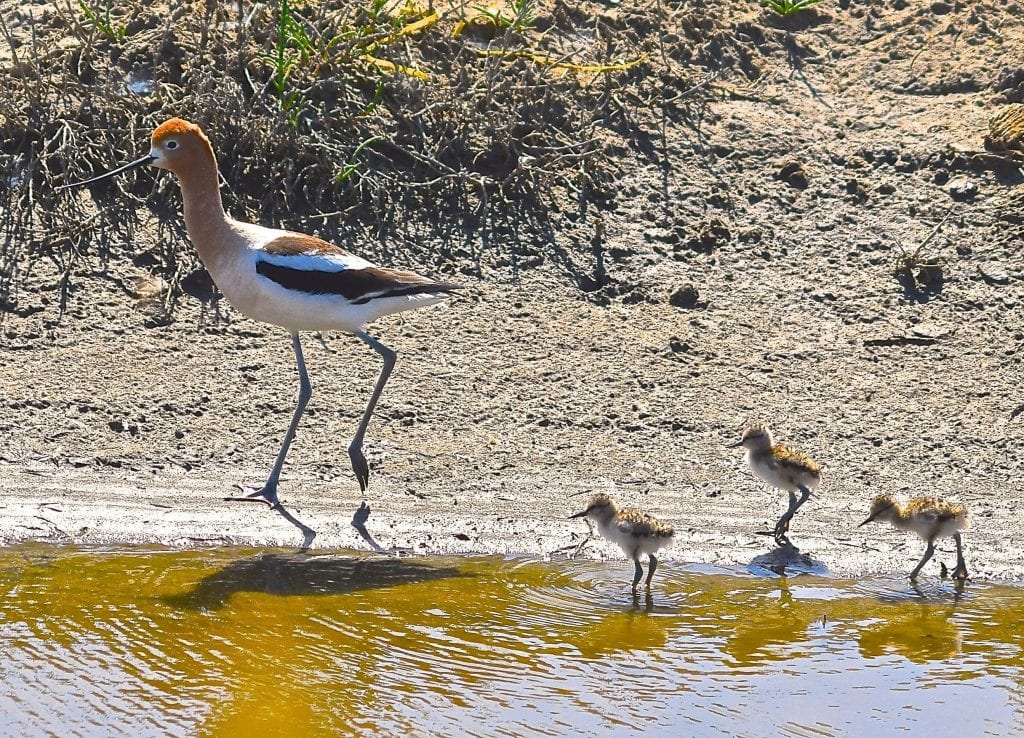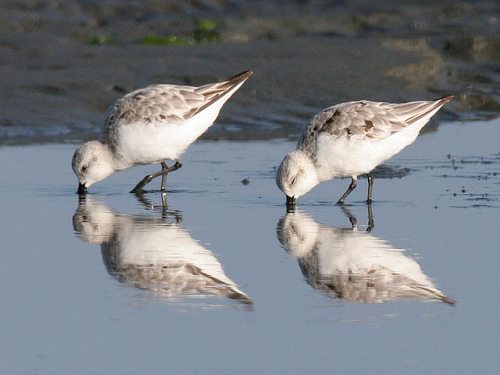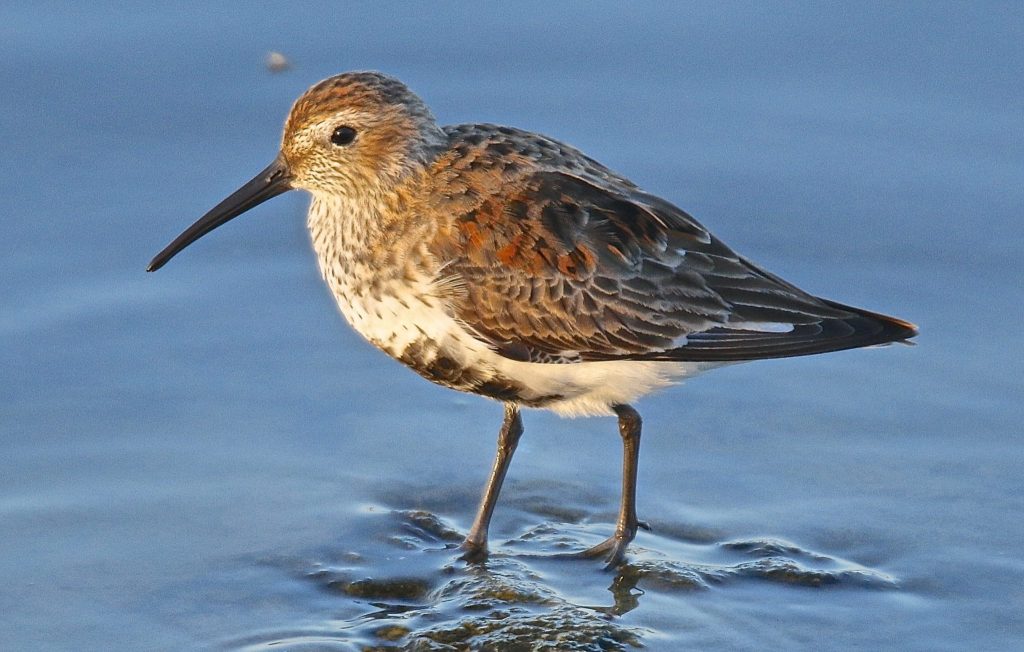Time to celebrate shorebird migration!
By Maureen Lahiff and Linda Carloni
Migration is always a natural wonder, whether of songbirds or Monarch butterflies or herds of caribou, but shorebird migration, following patterns from the Pleistocene, is truly an event to be noticed and treasured.
Now there’s even a special day to celebrate it – World Shorebirds Day, September 6, with global shorebird counts on the weekend of September 5-6!
First observed in 2014, World Shorebirds Day aims to raise global awareness of shorebirds and the challenges they face from loss of wetlands. It was founded by György Szimuly, also known as Szimi. He’s Hungarian, so he’s travelled to pursue his passion; he now lives in England. For more information, and some great photos and art, go to the website worldshorebirdsday.wordpress.com/.
San Francisco Bay is crucial for shorebirds
Even though more than 90 percent of San Francisco Bay’s original wetlands have been lost or seriously degraded by urban development, over 1 million shorebirds visit the Bay each year.

The Western Hemisphere Shorebird Reserve Network has designated San Francisco Bay as a Site of Hemispheric Importance – the network’s highest ranking of importance. According to the Southern Pacific Shorebird Conservation Plan (2003), the Bay Area holds higher proportions of the total wintering and migrating shorebirds on the U.S. Pacific coast than any other wetland. For 11 species, over half of the individual shorebirds counted on the Pacific Coast in a given season are found here. (That season is most often winter or fall, sometimes both.)
According to the conservation plan, there are 13 species for which the Bay shoreline is critical: Black-bellied Plover, Snowy Plover, Semipalmated Plover, Black Oystercatcher, American Avocet, Willet, Long-billed Curlew, Marbled Godwit, Black Turnstone, Western Sandpiper, Dunlin, Short-billed Dowitcher, and Red-necked Phalarope..
What is a shorebird, anyway?
Not all birds we see on the shore are classified as shorebirds for conservation and monitoring purposes. Gulls, for instance, are not considered shorebirds. One good description of a shorebird is a bird that feeds in wetlands by probing with its bill or picking up food from the surface. Many shorebirds such as curlews nest inland. Some sandpipers like Mountain Plovers are grassland birds — “grasspipers,” as Kevin McGowan of the Cornell Lab of Ornithology calls them. Not all shorebirds are limited to winter visits: Small numbers of Black-necked Stilts, American Avocets, Black Oystercatchers and threatened Western Snowy Plovers are here year round, though they can be difficult to find.


Shorebirds divide up the territory
When you see a number of different species of shorebirds feeding in close proximity, it’s worth taking a look at exactly where they are feeding. The birds have different foraging strategies, due to different lengths and types of bill. Their foraging area can vary from the grassy vegetation of the uplands, to beach or exposed mud, and into various depths of the water. Some species including Black Oystercatchers, Surfbirds, Wandering Tattlers, Black and Ruddy Turnstones, and Spotted Sandpipers forage on rocky rip-rap.
Some shorebirds, such as Black-bellied Plovers with their large black eyes, hunt by sight for critters on the surface. Recently, scientists have discovered that some shorebirds such as Western Sandpipers harvest food from the thin bio-film on the surface of the mud.
Many shorebirds probe with extremely sensitive bills with special receptors that detect pressure gradients in the sand. American Avocets “scythe,” sweeping their slightly open bills just below the surface of the water, filtering out small invertebrates. Black-necked Stilts also scythe.

When to see shorebirds
Nearly two-thirds of North American shorebird species that breed in the Arctic spend the winter in Central or South America. They fly fast, too, averaging 50 miles per hour and faster with a tail wind.
Many of these migrants pass through the Bay Area in the fall, giving us amazing chances to see large flocks of shorebirds in flight. You can find more information on North American shorebird migration here.
Shorebirds that nest in the High Arctic begin migrating south in July. Some stop here to feed and then fly on, such as Short-billed Dowitchers and Semipalmated Plovers, while others stay the winter. In July and August, many of them are still in the process of molting body feathers; you can see Black-bellied Plovers that actually have black bellies.

Now through the winter, and even into March and April, can be great times to see shorebirds.
Shorebirds’ daily activities are dictated by the tides rather than the solar day. They feed when the tide starts to go out, when there is exposed mudflat. When the tide is in, shorebirds gather along breakwaters or on islands, usually in mixed flocks. Some shorebirds seem to prefer foraging at night if the tide’s right. Even with help of sites like the NOAA Tides and Currents with graphs showing the tides ebb and flood, timing a visit for shorebirds can be tricky.
Where to see shorebirds
The simple answer is: Wherever there are wetlands, wherever there is shoreline, even in small parcels, there’s a good possibility of shorebirds. Along the Bay and on the coast, there are trails to see shorebirds, watch them feed, and observe their interactions.
A number of Golden Gate Bird Alliance field trips and classes visit shorebird sites, including Middle Harbor Shoreline Park, the Hayward Regional Shoreline, and Martin Luther King Jr. Regional Shoreline. Other great places are McLaughlin Eastshore State Park and along the Richmond Bay Trail, Land’s End in San Francisco, the Palo Alto Baylands Nature Preserve in San Mateo County, and the Napa-Sonoma Marshes Wildlife Area.


GGBA walks for World Shorebirds Day
Celebrate World Shorebirds Day with us! We’ll repeat our last year’s walk at Middle Harbor Shoreline Park, a haven for birds in the middle of the Port of Oakland, on Saturday, September 5, 2015. This trip will be led by Rusty Scalf. Meet at the mast at 9 a.m.
Then on Sunday, September 6, we’re sponsoring a trip at Crab Cove and the Elsie Roemer Bird Sanctuary along the Bay shore in Alameda, beginning at the foot of McKay Avenue by the Crab Cove Visitor’s Center at 8:30 a.m. This trip is led by Maureen Lahiff, co-author of this blog post.
We plan to register these sites as participants in the World Shorebirds Day census and submit our groups’ observations.
Learn more!
GGBA is offering a Water Birds in Fall class that starts in early November and is taught by the two authors of this blog post, Linda Carloni and Maureen Lahiff. Please see the Classes page of the GGBA website for more information; online registration opens on Wednesday, September 9, at 10:00 a.m.
————————————————————–
Linda Carloni and Maureen Lahiff both spent their earlier years in Ohio, where there is great birding, but nothing that compares with shorebirds in the Bay Area. They are graduates of the year-long Master Birder class co-sponsored by Golden Gate Bird Alliance and the California Academy of Sciences. Linda serves on the GGBA Board of Directors.
